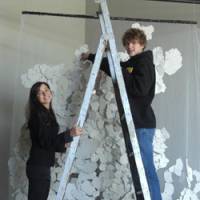It seems anything is possible at The American School in Japan. Take the standard procedure of inviting a guest to talk to the students. Most schools would settle for a well-known alumni; ASIJ gets Colin Powell and George Bush Sr. Now they're trying something new: a residency program where scholars or artists base themselves on campus for several months and work on a project with the students.
"The energy here is amazing," said American artist Daniel Rosen at the conclusion of his residency in February. "It has just been one of the most amazing experiences."
Rosen was standing before a screen made of hand-made porcelain pieces on which he was projecting a time-lapse sequence of video he had taken at the school. Students were crowded around the work, titled "MomentumMosaic," checking out the parts in which they appeared.
ASIJ high-school art teacher Glenda Baker explained that in the past the school had asked professional artists to attend classes and maybe teach the students special skills. But this was the first time they had asked an artist to base his own activities at the school.
"He got his own space and had a mandate to make a piece of work. He was encouraged to involve as many kids as he needed," Baker explained. It turned out that Rosen didn't need much encouragement.
"I'm not the guy who sits in the room and broods," he said. "I feed off other people's energy. I love collaborative work."
After setting the high-school kids to making the porcelain slices that would be used for the screen, he brought his video camera to the classroom and began taking hours of video footage that he later edited down to a 12-minute time-lapse sequence. Much of it developed spontaneously.
"One day I heard this kid playing guitar in the hall, and he was good. I recorded it and just worked his song into my piece," he explained. Michelle Kobayashi, a 12th-grade art student, was one of the members of the guitar player's band. They ended up making a cameo appearance midway through the video. "He made us walk in slow motion and play our instruments really slow — and then he played the video back really fast, so it looks normal," said Kobayashi, explaining Rosen's technique. "It was really hard, but it was really fun. It was amazing to see how he has a very specific style." The drum-playing Kobayashi said she is interested in studying photojournalism at college.
Another senior, art student Kei Kuwahara, said it was "exciting to work with someone who has a vision and ideas."
Interested in getting into filmmaking, Kuwahara said she learned from Rosen's flexibility. "He was open to changes and could relinquish control — that's an important tool for business or creative settings."
ASIJ headmaster Timothy Carr explained why having artists such as Rosen at the school is beneficial. "He's a practitioner sharing the passion of his craft. That's so empowering to the students," he said. In the future, ASIJ hopes to invite other scholars, including scientists and maybe an environmental expert.
The project met with the approval of another influential group in the ASIJ community: the parents. "The students got to see someone who actually is an artist, who makes a living out of doing art," said Parent Teacher Association Vice President Jane Hunsacker. It was a grant from the PTA that made the program possible.
"The school's great — they have a lot of things going on. We like to enrich by adding things," said PTA President Jere Miller. Both women had students involved in the residency — in high school and junior high, where Rosen made a second work. "They said it was really cool," reported Miller with a laugh.
The feeling on Rosen's part was mutual. Looking up at his video images flicking over the porcelain screen, he said the work wouldn't have been possible without the input from the kids. "I came with a concept, turned it over to the students, and, like all great collaborations, it ended up being something completely different," he said. "I couldn't have made it without them."



















With your current subscription plan you can comment on stories. However, before writing your first comment, please create a display name in the Profile section of your subscriber account page.